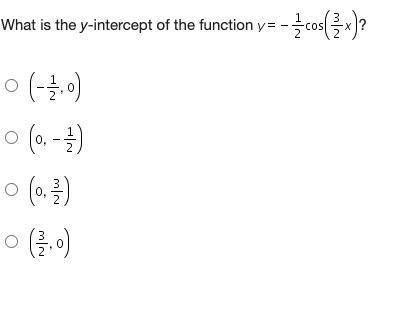
Mathematics, 07.10.2020 08:01 mattdallas6214
What is the y-intercept of the function y = negative one-half cosine (three-halves x)?
A. (negative one-half, 0)
B . (0, negative one-half)
C. (0, three-halves)
D. (Three-halves, 0)


Answers: 3


Another question on Mathematics

Mathematics, 21.06.2019 15:00
In a school 2/3 of the students study a language of those who study a language 2/5 study french
Answers: 2

Mathematics, 21.06.2019 16:10
On new year's day, the average temperature of a city is 5.7 degrees celsius. but for new year's day 2012, the temperature was 9.8 degrees below the average. i) if a represents the average temperature on new year's day and 7 represents the temperature on new year's day 2012, what formula accurately relates the two values together? ii) what was the temperature on new year's day 2012? dt a 0.8 ii) - 4 1 degrees celsius da-t-98 ii) 59 degrees celsius 1) 7 = -9,8 11) 59 degrees celsius ii) l degrees celsius
Answers: 2

Mathematics, 21.06.2019 19:30
Powerful women's group has claimed that men and women differ in attitudes about sexual discrimination. a group of 50 men (group 1) and 40 women (group 2) were asked if they thought sexual discrimination is a problem in the united states. of those sampled, 11 of the men and 19 of the women did believe that sexual discrimination is a problem. if the p-value turns out to be 0.035 (which is not the real value in this data set), then at = 0.05, you should fail to reject h0. at = 0.04, you should reject h0. at = 0.03, you should reject h0. none of these would be a correct statement.
Answers: 2

Mathematics, 21.06.2019 21:30
In a test for esp (extrasensory perception), the experimenter looks at cards that are hidden from the subject. each card contains either a star, a circle, a wave, a cross or a square.(five shapes) as the experimenter looks at each of 20 cards in turn, the subject names the shape on the card. when the esp study described above discovers a subject whose performance appears to be better than guessing, the study continues at greater length. the experimenter looks at many cards bearing one of five shapes (star, square, circle, wave, and cross) in an order determined by random numbers. the subject cannot see the experimenter as he looks at each card in turn, in order to avoid any possible nonverbal clues. the answers of a subject who does not have esp should be independent observations, each with probability 1/5 of success. we record 1000 attempts. which of the following assumptions must be met in order to solve this problem? it's reasonable to assume normality 0.8(1000), 0.2(1000)%30 approximately normal 0.8(1000), 0.2(1000)% 10 approximately normal srs it is reasonable to assume the total number of cards is over 10,000 it is reasonable to assume the total number of cards is over 1000
Answers: 1
You know the right answer?
What is the y-intercept of the function y = negative one-half cosine (three-halves x)?
A. (negative...
Questions



Biology, 25.11.2021 08:50

Engineering, 25.11.2021 08:50

Computers and Technology, 25.11.2021 08:50

Mathematics, 25.11.2021 08:50

Mathematics, 25.11.2021 08:50

Mathematics, 25.11.2021 08:50

Social Studies, 25.11.2021 08:50

Mathematics, 25.11.2021 09:00


Mathematics, 25.11.2021 09:00


Mathematics, 25.11.2021 09:00



History, 25.11.2021 09:00

Mathematics, 25.11.2021 09:00

Mathematics, 25.11.2021 09:00




